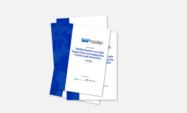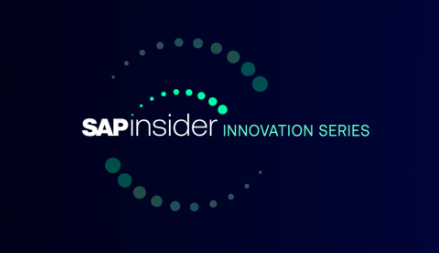SAP Supply Chain Management
SAP APO | SAP Asset Management | SAP Business Network | SAP Digital Manufacturing Cloud | SAP Digital Twin | SAP EWM | SAP IBP | SAP Inventory Management | SAP Label Printing | SAP Logistics | SAP Manufacturing | SAP Manufacturing Automation | SAP MES | SAP MII | SAP MM | SAP MRO | SAP MRP | SAP Order Management | SAP Plant Maintenance | SAP PLM | SAP Production Planning | SAP S&OP | SAP SD | SAP SPM | SAP Supply Chain Planning | SAP Track and Trace | SAP Transportation Management
Filter By
Browse By
- SAP Analytics and AI
- SAP Application Development and Integration
- All SAP Application Development and Integration
- SAP ABAP
- SAP ABAP Development Tools
- SAP ABAP Test Cockpit
- SAP API Management
- SAP BAPI
- SAP Basis
- SAP BRF
- SAP Business Application Studio
- SAP CMS
- SAP Design Studio
- SAP Development Tools
- SAP DevOps
- SAP EAI
- SAP EDI
- SAP Extension Suite
- SAP Fiori
- SAP Fiori Elements
- SAP Integration Suite
- SAP Low Code Application Development
- SAP Low Code Automation
- SAP Netweaver
- SAP Release Management
- SAP UI5
- SAP Web Application Server
- SAP Web IDE
- SAP Business Process Management
- SAP Center of Excellence
- SAP CIO
- SAP Customer Experience
- SAP Data and Data Management
- All SAP Data and Data Management
- SAP BW
- SAP BW/4HANA
- SAP Crystal Reports
- SAP Data Archiving
- SAP Data Center
- SAP Data Governance
- SAP Data Integration
- SAP Data Migration
- SAP Data Quality
- SAP Data Services
- SAP Data Strategy
- SAP Data Visualization
- SAP Data Warehouse Cloud
- SAP DMS
- SAP Document Control
- SAP EIM
- SAP ETL
- SAP ETL Tools
- SAP HANA
- SAP HANA Administration
- SAP HANA Deployment Infrastructure
- SAP HANA Studio
- SAP Master Data
- SAP Master Data Governance
- SAP MDM
- SAP Enterprise Architect
- SAP Enterprise Asset Management
- SAP ERP
- SAP Finance
- All SAP Finance
- SAP Accounting
- SAP AR AP
- SAP Asset Accounting
- SAP Billing Systems
- SAP BPC
- SAP BRIM
- SAP Cash Management
- SAP Central Finance
- SAP Controlling
- SAP COPA
- SAP Cost Center Accounting
- SAP Currency Risk
- SAP e-invoicing
- SAP FICO
- SAP Finance Automation
- SAP Advanced Financial Closing
- SAP Financial Consolidation
- SAP Financial Planning
- SAP FX Risk
- SAP General Ledger
- SAP Global Tax Management
- SAP Hyperion
- SAP Order to Cash
- SAP Payment Processing
- SAP Profitability Analysis
- SAP Rebate Management
- SAP S/4HANA Finance
- SAP SWIFT Compliance
- SAP Treasury Management
- SAP Universal Journal
- SAP Governance Risk and Compliance
- SAP Human Capital Management
- SAP Intelligent Technologies
- SAP Platform and Technology
- All SAP Platform and Technology
- SAP Business Technology Platform
- SAP Cloud
- SAP Cloud Connector
- SAP Cloud Integration Platform
- SAP Cloud Migration
- SAP Cloud Platform
- SAP Cloud Providers
- SAP Cloud Strategy
- SAP Digital Signature
- SAP Container Platform
- SAP HANA Enterprise Cloud
- SAP Digital Asset Management
- SAP Smart Forms
- SAP HEC
- SAP Digital Integration Hub
- SAP Hyperscalers
- SAP Infrastructure
- SAP Messaging
- SAP Quality and Testing
- SAP Security
- SAP Spend Management
- SAP Supply Chain Management
- All SAP Supply Chain Management
- SAP APO
- SAP Asset Management
- SAP Business Network
- SAP Digital Manufacturing Cloud
- SAP Digital Twin
- SAP EWM
- SAP IBP
- SAP Inventory Management
- SAP Label Printing
- SAP Logistics
- SAP Manufacturing
- SAP Manufacturing Automation
- SAP MES
- SAP MII
- SAP MM
- SAP MRO
- SAP MRP
- SAP Order Management
- SAP Plant Maintenance
- SAP PLM
- SAP Production Planning
- SAP S&OP
- SAP SD
- SAP SPM
- SAP Supply Chain Planning
- SAP Track and Trace
- SAP Transportation Management
- SAP System Administration
SAP Supply Chain: Supply Chain Management
A well-managed supply chain can significantly reduce a company’s operating expenses and increase profits. A supply chain requires active management because it is affected by many factors outside the control of the business. Current events causing global supply chain disruptions include the Russia-Ukraine War and the continuing effects of COVID-19.
SAP Supply Chain: Supply Chain Management
A well-managed supply chain can significantly reduce a company’s operating expenses and increase profits. A supply chain requires active management because it is affected by many factors outside the control of the business. Current events causing global supply chain disruptions include the Russia-Ukraine War and the continuing effects of COVID-19.
Supply chain management is the flow of goods or services between businesses and various locations to get goods to consumers faster and at less cost. Supply chain management encompasses a thread of activities from design and manufacturing to delivery and operations.
Components to enable a resilient and sustainable supply chain management process are:
- Designing recyclable and sustainable products
- Delivering products with low carbon impact
- Planning to reduce emissions and ethically source materials
- Operating in an energy efficient and safe manner
- Manufacturing with minimal waste and environmental impact.
Accurate information helps manufacturers and retailers produce and transport only what they can sell, eliminating unnecessary expenses. Consider simplification by integrating demand planning in the cloud. Predictive analytics, automation, and Internet of Things (IoT) technologies can connect and simplify processes, allowing you to gain visibility across forecasting, response and supply, replenishment, and inventory.
Key Capabilities of Supply Chain Management:
- Supply Chain Planning: Agile market-driven plans with visibility, collaboration, and intelligence.
- Supply Chain Logistics: Fast, efficient, and sustainable logistics.
- Manufacturing: Streamlining with artificial intelligence, loT, and integration.
- Product Lifecycle Management: Connecting systems, people, and processes with end-to-end digital innovation.
- Enterprise Asset Management: Improving asset performance and reliability.
Benefits of Supply Chain Management:
- Optimizing the flow of materials, products, and information.
- Improving data visibility.
- Enhancing financial practices and cost cutting.
- Improving vendor relationships.
- Operating with lean and on-demand inventory.
- Reducing liability and risk.
Key Considerations for SAPinsiders
- How to Deliver Greater Visibility into the Operational KPIs that Drive Your Business. In this webinar, hear insights from SAP around how to build a powerful analytics foundation. Discover how to focus less on historical KPI’s and more on predictive process automation, how to reprioritize KPIs that show historical performance, develop operational decision support for end-to-end supply chain processes, and stop development of custom reporting.
- 5 Ways to Enhance Your SCM with Smart Data. Explore expert insights from Robert Brice, President and CTO, RFgen. Start with the basics for a digital transformation of your supply chain, discover how to gain competitive advantage by implementing efficiencies, address inefficiencies, shortage of labor, and address security.
- Salling Group Expands Its Market Reach With SAP. In this article, see how Salling Group used SAP ERP to ensure data uniformity, enhance warehouse efficiency, and consolidated logistics transactions with Redwood.
558 results
-

 Premium
Premium
Adapt and Automate SAP Dispute Management
Reading time: 16 mins
Understand the concept of case records in the context of SAP Dispute Management and learn how to adapt the layout of a dispute case. Look into the implementation of Business Add-Ins within SAP Dispute Management to set up automatic follow-up activities such as determining the next processor of a dispute case. Key Concept SAP Financial...…
-

 Premium
Premium
Track the Lifecycle of Your Payments with SAP Bank Communication Management
Reading time: 14 mins
Become familiar with the new component SAP Bank Communication Management, which allows you to better track the approval process of outgoing payments in your SAP ERP system. Understand the integration of this component into SAP ERP Financials and learn some key concepts to set up the batching and status tracking of payment flows as well...…
-

Best Practices to Streamline Your Supply Chain Labeling from SAP and SAP S/4HANA
Reading time: 12 mins
Thank you for registering for this live Q&A. Find the transcript on supply chain labeling below. Matthew Shea: Hello, and welcome to today’s SAPinsider live Q&A. We will be chatting for the full hour about Enterprise Labeling Solutions and how SAP customers can leverage them to keep up with changing customer demands, comply with regulatory...…
-
-

 Premium
Premium
Plan, Optimize, and Execute with Advanced Supply Chain Tools Inside SAP ECC and SAP S/4HANA
The number one supply chain challenge for manufacturing and trade companies is connecting planning with operational execution. A key contributor to this challenge is a disconnect between supply chain planning systems and ERP. SAP ERP can store your data, account for your business, and transact with customers and suppliers, and should be used to plan…
-

- SAP Supply Chain Planning
 Premium
Premium
Managing Supply Chain Planning Outliers
Reading time: 3 mins
This article discusses why companies struggle to manage supply chain planning outlier events and suggests remedies. Membership Required You must be a member to access this content.View Membership LevelsAlready a member? Log in here
-

Understanding the Current and Future State of Supply Chains
November 10, 2022
Organizations need to understand the state of supply chains to detect bottlenecks, detect root cases and determine priorities. But the everchanging dynamics of planning, sales orders and inventory are constantly changing making it difficult. It’s important to know the current and future status of your supply chain to improve your supply chain KPIs. In this…
-

 Premium
Premium
Avoid Data Inconsistency in SAP NetWeaver BI in Just 5 Steps
Reading time: 10 mins
Failure to recognize data load dependencies between different data flows and objects can result in erroneous results and downtimes. Find out how you can address this using a five-step process. Key Concept Typical enterprise data warehouse scenarios involve a large amount of data consolidation, cleansing, and enrichment. These processes create dependencies on data load sequencing...…
-
-

- SAP Supply Chain Planning
 Premium
Premium
Webinar: Building Resilient and Agile Supply Chains Leveraging Data, Analytics and Automation
April 18, 2023
Supply chain challenges and associated risks are growing exponentially. These challenges surface in many forms, like unprecedented fluctuations in demand and supply, sudden disruptions impacting sourcing, manufacturing, and distribution, a proliferation of product offerings, and geopolitical and regulatory changes. These challenges have only intensified during the pandemic. As businesses evolve their supply chains to address…
-

Procurement Pivotal to Managing Disruptions Says SAP Research
Reading time: 2 mins
What keeps supply chain professionals up at night? According to research conducted by Regina Corso Consulting and released by SAP, 49% of supply chain professionals surveyed cited shortages and disruptions as their leading challenge, followed by sustainability (28%), and reducing costs and/or saving money (27%). While many companies have been plagued by these challenges, 90%…
-

Truck Manufacturer Taps LeverX and SAP Yard Logistics to Improve Floor Transport Load Planning
Reading time: 5 mins
A truck manufacturer, facing inefficiencies in spare parts transportation and order processing, implemented the SAP Yard Logistics solution in collaboration with LeverX to enhance real-time monitoring, automate shipping manifests, optimize forklift utilization, and streamline loading operations, ultimately improving supply chain efficiency and incident management.
Become a Member
Unlimited access to thousands of resources for SAP-specific expertise that can only be found here.
Become a Partner
Access exclusive SAP insights, expert marketing strategies, and high-value services including research reports, webinars, and buyers' guides, all designed to boost your campaign ROI by up to 50% within the SAP ecosystem.
Upcoming Events
Related Vendors
Your request has been successfully sent


